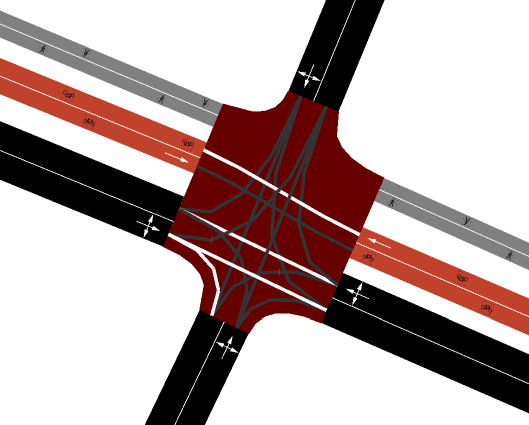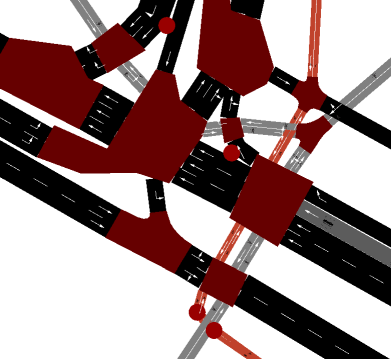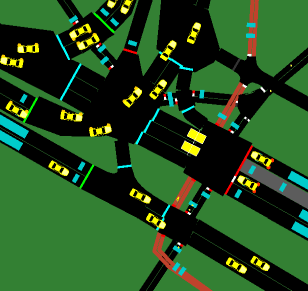|
Hey Jakob,
maybe it would be possible (and maybe relatively easy?) to
implement a dedicated pedestrian detector that reports true if any
pedestrians are inside its area that have not moved the timestep
before (or the number of those pedestrians). That would be much
like an E2 detector. Similar to your idea, but not bound to a
particular crossing. Or does that not accommodate the situation
you describe with 4 possible outgoing directions? Direction is
then typically not important, since pedestrians that just crossed
will typically walk onward.
The detector could even be generic, a kind of special type of E2
detector, and just report all waiting/not-moving vehicles inside
its area - or an option for an E2 detector 'only report waiting
vehicles' or so. Then again, pedestrians are not actually
vehicles, which might complicate that idea bit.
Greets, Menno
On 27/08/2019 20:17, Jakob Erdmann
wrote:
There is no strong technical reason that prevents
E2-detectors from handling pedestrians. It might also be
useful to configure it for detecting pedestrians either in
forward, backward or both directions. However, that still
would not solve the use case of a pedestrian push-button.
This is because pedestrians wait on an walkingarea before
using a crossing and there may be more than 2 directions in
which this walkingarea is used. At a junction corner with 2
sidewalks and 2 crossings, there are actually 4 possible
(outgoing) walking directions and 2 push-buttons that must be
distinguished.
I think it makes more sense to implement a dedicated
pedestrian detector that can be used to query the number of
pedestrians that are waiting for a particular crossing (and
maybe even combines the pedestrians from both sides of the
same crossing).
An alternative solutions (maybe more elegant) would be to
add a function to traci.trafficlights that can report the
number of waiting pedestrians for a given phase (by checking
all the crossings that would turn green in that phase).
regards,
Jakob
Hello Jakob,
thanks for your reply.
Is detection of pedestrians by E2 detectors a planned
feature? Or is it just not meant to function that way.
Anyway I noticed that if I use --persontrips true with
od2trips, SUMO does not find connections for pedestrians
the way I modeled my network now (with connections instead
of crossings). The simulations reports an error. So that
I'd need to revise the network there anyway.
For now, I will stick with my incorrect approach, since
it allows for much easier detection of pedestrians, with a
single TraCI command. Also I find creating connections
somewhat more intuitive than creating crossings in
NETEDIT. It would be nice to be able to model pedestrians
as vehicles, and still have them walk alongside one
another on a sidewalk, maybe even in both directions,
instead of in a line. But that is probably just not a
typical use case.
Thanks, greets,
Menno
On
26/08/2019 17:23, Jakob Erdmann wrote:
Dear all,
currently, when modelling pedestrians, I always
use 'regular' edges and connections. This results
in warnings (such as "Warning: Vehicle type '7'
with vClass=pedestrian should only be used for
persons and not for vehicle 'ped26'."), and
sometimes pedestrians accidentally end up on the
street (which I can solve by disallowing them). I
do nonetheless because: it allows usage of E2 type
detectors to detect presence of pedestrian-style
vehicles, and it is easy to build the network
cause I can just use regular connections.
Pedestrians will stand in line at the
intersection, but I am mostly interested in the
general flow of traffic, and there are generally
few pedestrians in the simulation.
However, it would be nice to model the
pedestrians more correctly. I wonder, given an
intersection like this:

How can I build the network so that the
pedestrians will only cross from the sidewalk
edges on the one side to the sidewalk edges on the
other side, and have a detector (button) on either
side of the crossing? Beause of the way my TraCI
application works, most preferably this would be
an E2 detector.
Should I create sidewalk-edges only in a single
direction, since pedestrians can walk in two
directions? If so, how to avoid pedestrians that
just crossed the intersection from activating the
detection?
Actually all traffic has detectors, that I did
add draw in the above simplified example. A
typical intersection may look more like this:

And in the simulation like this (note a lot of
traffic lights are light blue, and thus actually
not controlled):

any help is appreciated!
Greets, Menno
_______________________________________________
sumo-user mailing list
sumo-user@xxxxxxxxxxx
To change your delivery options, retrieve your
password, or unsubscribe from this list, visit
https://www.eclipse.org/mailman/listinfo/sumo-user
_______________________________________________
sumo-user mailing list
sumo-user@xxxxxxxxxxx
To change your delivery options, retrieve your password, or unsubscribe from this list, visit
https://www.eclipse.org/mailman/listinfo/sumo-user
_______________________________________________
sumo-user mailing list
sumo-user@xxxxxxxxxxx
To change your delivery options, retrieve your password, or
unsubscribe from this list, visit
https://www.eclipse.org/mailman/listinfo/sumo-user
_______________________________________________
sumo-user mailing list
sumo-user@xxxxxxxxxxx
To change your delivery options, retrieve your password, or unsubscribe from this list, visit
https://www.eclipse.org/mailman/listinfo/sumo-user
|



